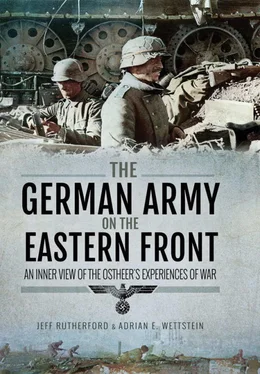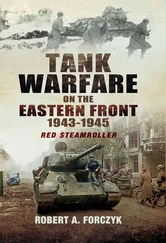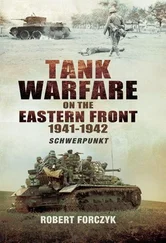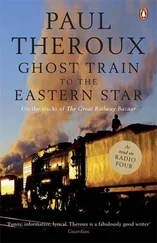The military events of the war in the east – centred on the signpost battles of Moscow, Stalingrad, Kursk, and Bagration – were clearly unprecedented in European history in terms of size and scale, and they differentiate the Nazi-Soviet war from other conflicts during the Second World War. The essence of the war waged by the Nazi state in the east, however, was also far different from the war it waged in the west. The ultimate goal of the campaign was the complete destruction of the Soviet state and society, so that the area could be integrated into a racial empire that encompassed Central and Eastern Europe under the allegedly superior Aryan – or German – race. Plans to plunder, exploit, enslave, and eventually to commit the mass murder of various population groups in the Soviet Union underpinned the Nazi state’s approach to the conflict – what has been termed the Vernichtungskrieg , or war of annihilation – and it seeped into both army planning and practice.
While German intentions towards the Soviet Union were laid bare in the planning process – most notably through the complex of orders referred to as the ‘criminal orders’ – it was during the course of the campaign that German policy underwent a marked radicalization. Autumn 1941 brought a new phase in what soon developed into a ruthless occupation policy – one that the army significantly contributed to – up until the end of the winter crisis period. Following its conclusion, army policy fluctuated between periods of reconciliation and coercion, depending not only on the German perception of the situation, but also on the attitudes of commanders on the spot. At the base of most German military policies lay the concept of military necessity; the attempt to secure the combat efficiency of the army in order to achieve victory on the battlefield, no matter the ethical or moral cost. This concept at times led the army to wage a war that corresponded to the ideological struggle demanded by the state, while at other points in time it drove army policies that contradicted state goals. Military necessity is therefore essential in connecting the war of annihilation with the war against the Red Army.
The research of the last twenty years has shed new light on the German war in the east as it centred on German criminal orders and the practices initiated, supported or at least tolerated by the military, including the rather conservative army. This research has not only focused on the criminally negligent and even genocidal German treatment of Soviet POWs and the beginnings of the Holocaust through the murders of Soviet Jews and other groups specially persecuted by the National Socialist regime, but it has also examined occupation policies that included the Starvation Plan, which intended that some 30 million Soviet citizens die of hunger and the diseases it caused, the carrying out of criminal orders such as the Commissar Order, the exploitation of Soviet economic resources, particularly agriculture, the forced deportation of workers to Germany, and finally the excessive and brutal anti-partisan warfare waged by the Germans and their Axis allies. While few still doubt that the German military leadership and army itself was actively involved in the war of annihilation in 1941, many other issues are still open to debate. Only a limited number of studies on the German army examine the war in the east beyond the winter crisis of 1941/42, and the few that have indicate that local approaches provided a multitude of occupation policies rather than one unified line of action. The involvement of the individual soldier is also debated, as is the question of which arms or branches were more involved – at this point, for example, we lack a study that examines the Luftwaffe’s involvement in the war of annihilation. A further difficult debate concerns the relationship between the German military and the National Socialist system and its ideology. While there were clearly numerous overlapping ideas between the military and National Socialism, it is difficult to see the cause and effect between the two value systems: where did Nazi ideology fundamentally transform German military thinking, and where did it merely radicalize pre-existing German military thought? An even more difficult discussion considers the influence of Soviet warfare on the conduct of war. While most historians agree that it accelerated the spiral of violence through its own atrocities, we simply lack sufficient research on the Red Army’s contribution to this state of affairs – and unfortunately will for many years to come.
The recent focus on the war of annihilation, however, has led to a neglect of archive-based operational studies, so that many newer works still rely on the notoriously unreliable memoirs of generals or on studies more than forty years old. The relatively few new operational studies have demonstrated the necessity of further research into this area of military history. One of the persistent problems in the analysis of the Nazi-Soviet war is that there are few connections made between these two main lines of research – operational studies often enough pay no attention to these ‘irrelevant matters’ of occupation policy (or are written by people defending the ‘clean’ Wehrmacht ), while many historians of the war of annihilation lack a fundamental understanding of military matters (which at times even weakens their approach to the topic). Finally, numerous areas important for both lines of research and which sometimes connect them, such as logistics, command, training or troop care, have received only limited research attention.
This book addresses some of these issues by presenting sources that generally originate from the mid-command level, that is, the corps to regimental level, and concentrates on the period between June 1941 and summer 1944. Several sources are presented in full or are quoted extensively to give readers a first-hand perspective on German military thinking about the war and how the army perceived and understood the conflict. It also allows the reader to get an idea about the nature of such sources, as well as of the nuances, subtleties, and even contradictions that emerge in German military documents. These are issues that are often lost when simply quoting small sections of documents.
The documents are grouped by topic into seven thematic chapters, covering the issues of combat, command, tactics and organization, supply, occupation, training, and motivation. A cursory glance at the various documents will highlight the interconnection of many of the various orders, directives, and reports. For example, it is difficult to separate combat from supply, training from command, and occupation from motivation; rather the various facets of the German army’s experience of war reinforced one another in creating the particular way in which the Germans fought and understood the war in the east. They also provide evidence of a rather fragmented approach to the war against the Soviets. While this should not come as a surprise in consideration of the number of men involved and the constant evolution of the army’s policies and practices, it does indicate that the narrative of a monolithic German army that operated in lock-step with central directives requires revision.
The book’s approach sketched above has some limits. This study is not a chronological history of events on the Eastern front. It is also not a comprehensive look at the Eastern front, as the analysis of the Soviet Union and the Red Army, as well as that of the Third Reich outside the Eastern front, i.e. the German armaments industry, receives only cursory discussion. Its focus remains squarely on how the war was fought, experienced, and understood by the German army from the army level to that of the individual soldier.
In the translation and editing of the sources there were many obstacles to overcome. Translation and editing is always an exercise in interpretation, and we had many discussions about possible ways to translate words or sentences. In some cases, we decided to leave a term in the original German. In a few cases, the German term has become common in English (like Führer ). In most cases, however, we decided that if the German word had a meaning – in our case often influenced by National Socialist ideology or coined by long German military tradition – that was difficult to translate accurately into English, we would leave it in the original German and enter it into an accompanying glossary. Ranks are also not translated. Another difficulty was to remain as close as possible to the German sources, but at the same time achieve a readable English, especially for those new to the field of German military history. We made many necessary compromises on these issues, which someone else may have approached differently.
Читать дальше






![John Stieber - Against the Odds - Survival on the Russian Front 1944-1945 [2nd Edition]](/books/405234/john-stieber-against-the-odds-survival-on-the-russian-front-1944-1945-2nd-edition-thumb.webp)





